|
|
|
Sort Order |
|
|
|
Items / Page
|
|
|
|
|
|
|
| Srl | Item |
| 1 |
ID:
091702


|
|
|
|
|
| Publication |
2009.
|
| Summary/Abstract |
Electricity demand in South Africa has grown at a very rapid rate over the past decade. As part of reform initiatives to enhance long-term sustainability of the country's electricity industry, South Africa's authorities have in recent years sought to develop an electricity pricing framework that is cost reflective and forms the cornerstone of demand management schemes meant to foster changes in consumption behaviour and enhance efficiency in resource use. The effects of any pricing policy on aggregate electricity consumption will depend on a useful understanding of the factors that influence electricity demand, and the magnitude to which electricity demand responds to changes in such factors. In this context, this paper applies the bounds testing approach to cointegration within an autoregressive distributed lag framework to examine the aggregate demand for electricity in South Africa during the period 1960-2007. The results indicate that in the long run, income is the main determinant of electricity demand. With electricity prices having an insignificant effect on aggregate electricity demand, future pricing policies will need to ensure that electricity prices are cost reflective and enhance efficiency of electricity supply and use.
|
|
|
|
|
|
|
|
|
|
|
|
|
|
|
|
| 2 |
ID:
104901


|
|
|
|
|
| Publication |
2011.
|
| Summary/Abstract |
We report on an assessment of the potential for energy production from on-farm anaerobic digestion (AD) in England based on findings from a survey of farmers where it was found that around 40% of 381 respondents might install AD on their farms. These 'possible adopters' tended to have large farms and might together utilise some 6560 ha of land for feedstock production along with the wastes from some 12,000 beef and dairy cattle and 9000 pigs. When raised to the national level, such a level of AD activity would produce around 3.5 GWh of electricity. This approximates to just 0.001% of national electricity generation. Further, there are considerable perceived barriers to the widespread adoption of AD on farms in England; these include the high capital costs of installing AD and doubts about the economic returns being high enough.
|
|
|
|
|
|
|
|
|
|
|
|
|
|
|
|
| 3 |
ID:
166505


|
|
|
|
|
| Summary/Abstract |
Hydropower plants (HPPs) have played a key role in the Brazilian electric sector for over a century. As the different options for the generation of electricity are being increasingly scrutinized in terms of their sustainability, the assessment of the social, economic and environmental impacts has become a strategic factor to support investment decisions geared to expand the power supply. In this study, the construction and operation of a large group of Brazilian HPPs with over 100 MW of installed power was assessed based on the econometric analyses of 28 municipal indicators related to social, economic and environmental issues. Despite the broad variety of indicators analyzed, some environmental interferences typically attributed to HPPs such as a reduction in biodiversity and the interruption of fish migration routes were not assessed due to the lack of indicators. Overall, the study shows that the construction and operation of HPPs benefits mainly the economic activities. On the other hand, the indicators related to public health and safety, including the incidence of water-borne diseases and tropical parasitosis, bear no relation with the analyzed processes, except for the human fertility factor. In terms of Education, one of the indicators declined both during construction and operation stage.
|
|
|
|
|
|
|
|
|
|
|
|
|
|
|
|
| 4 |
ID:
104929


|
|
|
|
|
| Publication |
2011.
|
| Summary/Abstract |
A relationship exists for the liberalised Australian electricity supply industry between institutional structures and technological change. The traditional institutional framework has been based on centralised generation and a regulated vertically integrated monopoly structure. This paper investigates the issues of institutional and technological change using the social cost perspective (including externalities), and focuses on the imperatives of greenhouse gas emission reductions.
An Australian context has been chosen for the paper, in light of a proposed price on carbon; be that via an emission trading scheme or carbon tax. The power generation sector is dominated by coal- and gas-fired power plants due to the large reserves of coal and gas available in Australia. If carbon pricing of up to AU$40/tCO2 is introduced then the merit order for dispatch changes but coal-fired power generation sources remain an option.
|
|
|
|
|
|
|
|
|
|
|
|
|
|
|
|
| 5 |
ID:
094251


|
|
|
|
|
| Publication |
2010.
|
| Summary/Abstract |
Similar to other developing countries the electricity sector in Lebanon is monopolized by a vertically integrated public utility, Electricite Du Liban (EDL). EDL's supply is characterized by frequent and lengthy power cuts that have given rise to an alternative, informal, and unregulated backup sector, which serves to satisfy electricity demand during the extended blackout periods. This paper examines the evolvement of the backup sector and its related CO2 emissions via the use of scenario analysis. The economic and energy policy implications of each scenario are discussed and a number of policy options are presented to ensure that the growth in CO2 emissions is contained. Results clearly indicate that the backup sector plays a critical role in the success of any greenhouse gas mitigation commitment undertaken by Lebanon. A clear strategy on dealing with this sector needs to be devised simultaneously if not prior to any climate change policy at the national level.
|
|
|
|
|
|
|
|
|
|
|
|
|
|
|
|
| 6 |
ID:
118109


|
|
|
| 7 |
ID:
088019
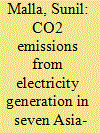

|
|
|
|
|
| Publication |
2009.
|
| Summary/Abstract |
The Logarithmic Mean Divisia Index (LMDI) method of complete decomposition is used to examine the role of three factors (electricity production, electricity generation structure and energy intensity of electricity generation) affecting the evolution of CO2 emissions from electricity generation in seven countries. These seven countries together generated 58% of global electricity and they are responsible for more than two-thirds of global CO2 emissions from electricity generation in 2005. The analysis shows production effect as the major factor responsible for rise in CO2 emissions during the period 1990-2005. The generation structure effect also contributed in CO2 emissions increase, although at a slower rate. In contrary, the energy intensity effect is responsible for modest reduction in CO2 emissions during this period. Over the 2005-2030 period, production effect remains the key factor responsible for increase in emissions and energy intensity effect is responsible for decrease in emissions. Unlike in the past, generation structure effect contributes significant decrease in emissions. However, the degree of influence of these factors affecting changes in CO2 emissions vary from country to country. The analysis also shows that there is a potential of efficiency improvement of fossil-fuel-fired power plants and its associated co-benefits among these countries.
|
|
|
|
|
|
|
|
|
|
|
|
|
|
|
|
| 8 |
ID:
088044


|
|
|
|
|
| Publication |
2009.
|
| Summary/Abstract |
Turkish electricity sector has undergone significant institutional changes since 1984. The recent developments since 2001 including the setting up of a regulatory agency to undertake the regulation of the sector and increasing participation of private investors in the field of electricity generation are of special interest. This paper estimates cost functions and investigates the degree of scale economies, overinvestment, and technological progress in the Turkish electricity generation sector for the period 1984-2006 using long-run and short-run translog cost functions. Estimations were done for six groups of firms, public and private. The results indicate existence of scale economies throughout the period of analysis, hence declining long-run average costs. The paper finds empirical support for the Averch-Johnson effect until 2001, i.e., firms overinvested in an environment where there are excess returns to capital. But this effect was reduced largely after 2002. Technological progress deteriorated slightly from 1984-1993 to 1994-2001 but improved after 2002. Overall, the paper found that regulation of the market under the newly established regulating agency after 2002 was effective and there are potential gains from such regulation.
|
|
|
|
|
|
|
|
|
|
|
|
|
|
|
|
| 9 |
ID:
103488


|
|
|
|
|
| Publication |
2011.
|
| Summary/Abstract |
Energy intensity of the total primary energy supply (TPES), total final energy consumption (TFC) and LOSSES in the conversion from TPES to TFC were analyzed for the World, OECD and Rest of the World (ROW) countries. LOSSES increased significantly for all groups of countries due to the increase of electricity production from coal in the period studied (1971-2008). Electricity share final consumption almost doubled, increasing from 8.8% to 17.2% in the period studied. However the energy intensity of LOSSES remained practically constant, which reflects the fact that the efficiency of electricity generation from coal (the main source of electricity) remained practically constant in that period. Despite the attractiveness of end-use devices running on electricity such as computers, which is typical of modern societies, the CO2 emissions are bound to increase unless coal is replaced by less carbon emitting sources such as natural gas, renewables and nuclear energy.
|
|
|
|
|
|
|
|
|
|
|
|
|
|
|
|
| 10 |
ID:
117233


|
|
|
|
|
| Publication |
2013.
|
| Summary/Abstract |
Electricity generation in China mainly depends on coal and its products, which has led to the increase in CO2 emissions. This paper intends to analyze the current status of CO2 emissions from electricity generation in China during the period 1991-2009, and apply the logarithmic mean Divisia index (LMDI) technique to find the nature of the factors influencing the changes in CO2 emissions. The main results as follows: (1) CO2 emission from electricity generation has increased from 530.96 Mt in 1991 to 2393.02 Mt in 2009, following an annual growth rate of 8.72%. Coal products is the main fuel type for thermal power generation, which accounts for more than 90% CO2 emissions from electricity generation. (2) This paper also presents CO2 emissions factor of electricity consumption, which help calculate CO2 emission from final electricity consumption. (3) In China, the economic activity effect is the most important contributor to increase CO2 emissions from electricity generation, but the electricity generation efficiency effect plays the dominant role in decreasing CO2 emissions.
|
|
|
|
|
|
|
|
|
|
|
|
|
|
|
|
| 11 |
ID:
124283


|
|
|
|
|
| Publication |
2013.
|
| Summary/Abstract |
Pyrolysis is an alternative form of renewable energy production and a potential source of greenhouse gas emissions mitigation. This study examines how poplar-based biochar can be applied in Taiwan for electricity generation and for soil improvement and to what extent it brings economic and environmental benefits. It is a preliminary study and focuses on the balances of different economic and environmental items. This paper reports on a case study examination of the economic and greenhouse gas implications of pyrolysis plus biochar utilization. The case study involves using poplar grown on set-aside land in Taiwan with the biochar applied to rice fields. We examine both fast and slow forms of pyrolysis and find how the profitability varies under different price structures. The results show that fast pyrolysis is more profitable than slow pyrolysis under current electricity price, GHG price and crop yield as the slow pyrolysis generates relatively less electricity but lower value product-biochar. We also find that fast pyrolysis and slow pyrolysis offset about 1.4 t and 1.57 t of CO2 equivalent per ton of raw material, respectively.
|
|
|
|
|
|
|
|
|
|
|
|
|
|
|
|
| 12 |
ID:
132770
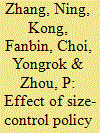

|
|
|
|
|
| Publication |
2014.
|
| Summary/Abstract |
This paper examines the effect of size control policy on the energy and carbon efficiency for Chinese fossil fuel power industry. For this purpose, we propose two non-radial directional distance functions for energy/carbon efficiency analysis of fossil fuel electricity generation. One is named a total-factor directional distance function that incorporates the inefficiency of all input and output factors to measure the unified (operational and environmental) efficiency of fossil fuel power plants, and the other is called an energy-environmental directional distance function that can be used to measure the energy-environmental performance of fossil fuel electric power plants. Several standardized indicators for measuring unified efficiency and energy-environmental performance are derived from the two directional distance functions. An empirical study of 252 fossil fuel power plants in China is conducted by using the proposed approach. Our empirical results show that there exists a significant positive relationship between the plant size and unified efficiency, the five state-owned companies show lower unified efficiency and energy-environmental performance than other companies. It is suggested that Chinese government might need to consider private incentives and deregulation for its state-owned enterprises to improve their performance proactively.
|
|
|
|
|
|
|
|
|
|
|
|
|
|
|
|
| 13 |
ID:
132592


|
|
|
|
|
| Publication |
2014.
|
| Summary/Abstract |
Forecasting of electricity demand has assumed a lot of importance to provide sustainable solutions to the electricity problems. LEAP has been used to forecast electricity demand for the target year 2030, for the state of Maharashtra (India). Holt's exponential smoothing method has been used to arrive at suitable growth rates. Probable projections have been generated using uniform gross domestic product (GDP) growth rate and different values of elasticity of demands. Three scenarios have been generated which include Business as Usual (BAU), Energy Conservation (EC) and Renewable Energy (REN). Subsequent analysis on the basis of energy, environmental influence and cost has been done. In the target year 2030, the projected electricity demand for BAU and REN has increased by 107.3 per cent over the base year 2012 and EC electricity demand has grown by 54.3 per cent. The estimated values of green house gas (GHG) for BAU and EC, in the year 2030, are 245.2 per cent and 152.4 per cent more than the base year and for REN it is 46.2 per cent less. Sensitivity analysis has been performed to study the effect on the total cost of scenarios. Policy implications in view of the results obtained are also discussed.
|
|
|
|
|
|
|
|
|
|
|
|
|
|
|
|
| 14 |
ID:
191133
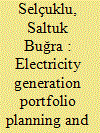

|
|
|
|
|
| Summary/Abstract |
Türkiye is the fastest-growing energy market among the OECD members, and it is among the world's top 20 energy-consuming countries. The existing electricity generation capacity of Türkiye has doubled in the last decade. Planning the electricity generation portfolio is an important problem for the decision and policymakers, especially in terms of sustainable development, and it is crucial for Türkiye's economic growth. In this paper, we study the long-term electricity generation portfolio optimization while considering the uncertainties. An optimization algorithm is modeled and solved while integrating uncertainty information as part of the Pareto concept. The results of three scenarios are presented and policy implications are discussed and compared with similar Turkish case studies and government projections. The results suggest that it is less risky to minimize emissions, thus, more likely to be sustainable than to minimize costs. Comparisons among solutions show that nuclear is a substitute for renewable resources and comparisons among other studies show that natural gas and hydro are substitutes for each other. Multi-objective formulation reveals that the government's scenario provides favorable results in business-as-usual conditions; however, nuclear and renewable investments that the government has planned are too ambitious to keep costs lower while decreasing emissions.
|
|
|
|
|
|
|
|
|
|
|
|
|
|
|
|
| 15 |
ID:
124188


|
|
|
|
|
| Publication |
2013.
|
| Summary/Abstract |
The entire life cycle of a municipal solid waste (MSW) oxy-fuel incineration power plant was evaluated using the method of life cycle assessment (LCA) to identify and quantify the fossil energy requirements and environmental impacts. The functional unit was 1000 kg (1 t) MSW. During the life cycle, the saving standard coal by electricity generation was more than diesel consumption, and the effect of soot and ashes was the greatest among all calculated categorization impacts. The total weighted resource consumption and total weighted environment potential of MSW oxy-fuel incineration were ?0.37 mPR90 (milli person equivalent) and ?0.27 PET2010 (person equivalent), better than MSW incineration with CO2 capture via monoethanolamine (MEA) absorption. The sensitivity analysis showed that the electric power consumption of air separation unit (ASU) was the primary influencing parameter, and the influence of electric power consumption of CO2 compressor was secondary, while transport distance had small influence. Overall, MSW oxy-fuel incineration technology has certain development potential with the increment of MSW power supply efficiency and development of ASU in the future.
|
|
|
|
|
|
|
|
|
|
|
|
|
|
|
|
| 16 |
ID:
121323
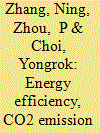

|
|
|
|
|
| Publication |
2013.
|
| Summary/Abstract |
This paper proposes a meta-frontier non-radial directional distance function to model energy and CO2 emission performance in electricity generation. This approach allows for the consideration of the group heterogeneity of electricity generation, non-radial slacks, and undesirable outputs simultaneously. We extend several standardized indices to measure total-factor energy efficiency, CO2 emission performance, and technology gaps in electricity generation. We estimate the potential reductions in energy use and CO2 emissions under different technology assumptions. We conduct an empirical analysis of fossil fuel electricity generation in Korea by using the proposed approach. The results indicate that coal-fired power plants show higher levels of total-factor energy efficiency and CO2 emission performance than oil-fired ones. Under the meta-frontier technology assumption, coal-fired power plants show a smaller technology gap than oil-fired ones. This suggests that the Korean government should promote technological innovation to reduce technology gaps for oil-fired plants, thereby improving energy and CO2 emission performance and meeting emission reduction targets in the electricity generation industry.
|
|
|
|
|
|
|
|
|
|
|
|
|
|
|
|
| 17 |
ID:
128335


|
|
|
|
|
| Publication |
2014.
|
| Summary/Abstract |
The increase of fossil fuel demand raises concerns on availability of resources for future energy demand and on potential environmental impacts. Electric vehicles (EVs) appear as one alternative to shift from fossil fuels to renewable energy resources. This research work analyzes the benefits of the introduction of EVs in a small energy system, the Flores island, Azores, in terms of primary energy and CO2 emissions. Four scenarios were designed considering different penetration rates of EVs (Low and High) and different time of recharging strategies (Fixed and Flexible). The high shares of RES in the electricity production system (60-62%) did not guarantee a significant use of RES for the recharging of EVs (10-40%), as the additional electricity required had to be produced mainly from the diesel generators. The flexible recharging strategies allowed doubling the share of RES in the recharging of the EVs when compared to fixed recharging, and consequently double the impact on the reduction of primary energy consumption and fossil fuels imports. While the reduction of primary energy ranged between 0.2% and 1.1%, for CO2 emissions there was a decrease between 0.3 and 1.7%, proving that EVs can help improve the sustainability of energy systems.
|
|
|
|
|
|
|
|
|
|
|
|
|
|
|
|
| 18 |
ID:
124304


|
|
|
|
|
| Publication |
2013.
|
| Summary/Abstract |
China has made improving the thermal efficiencies of its coal-fired power plants a national priority. Official data show that the average thermal efficiency was enhanced from 31.3% in 2000 to 33.2% in 2005 and 36.9% in 2010. This paper aims to assess the validity of China's claimed improvement, examine major responsible factors, and identify future improvement opportunities. Recognizable factors can account for about 80% of the reported progress in the 10th Five-Year Plan (2001-2005) and about 85% in the 11th (2006-2010) to largely verify the reported progress. Engineering approaches-especially replacing inefficient power units with more efficient ones-are the largest contributing factors, while optimization approaches-particularly electricity dispatch-remains inefficient in China. In 2010, the explainable efficiency improvement might have avoided around 500 million tons of CO2 emissions. In comparison, although the United States was fairly static with most of its coal-fired power plants seriously outdated, it has more efficient electricity dispatch. In China's ongoing 12th Five-Year Plan (2011-2015), better dispatch patterns could be more important as opportunities for improvement through engineering approaches have been largely exhausted.
|
|
|
|
|
|
|
|
|
|
|
|
|
|
|
|
| 19 |
ID:
098601


|
|
|
|
|
| Publication |
2010.
|
| Summary/Abstract |
The power sector in Nigeria is undergoing structural reforms aimed at improving and expanding the current grid generation capacity and distribution network. The Government has injected huge funds into this sector while also granting licences to private companies for the provision of electricity. It is also aiming to increase electricity generation capacity to 25,000 MW by 2020 from the current installed capacity of 6500 MW while also pledging to connect 75% of the population to the grid from the current 40% by 2025. This paper sets out to analyse the implications of the energy policy in Nigeria and presents the life cycle environmental and economic analysis of the current and future electricity sector. The results show that all the life cycle impacts and economic costs increase significantly over the time-period (2003-2030), but at different rates depending on the types of technologies deployed. Renewables such as large hydro and solar proposed by the Government have a potential to reduce the overall life cycle environmental impacts from the electricity mix, considering their lower environmental impacts compared to fossil-fuels. However, this requires a five-fold increase in grid investments from the current US$1.7 billion per year to US$9.40 billion by 2030.
|
|
|
|
|
|
|
|
|
|
|
|
|
|
|
|
| 20 |
ID:
111339
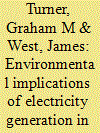

|
|
|
|
|
| Publication |
2012.
|
| Summary/Abstract |
Long-term, integrated modelling of electricity generation capacity and its operational requirements is important for coherent energy policy because of the multi-decadal lifespan of such plant, and because related fuel requirements, water consumption, and greenhouse gas emissions impact other sectors. This paper describes a physical model of electricity generation designed for long-term simulations, including the reproduction of decades of historical data, and its application to key policy questions. The simulation uses a dynamic, physical input-output model for the basic material and energy industries, embedded in an economy-wide stocks and flows framework (SFF). The historical reproduction, illustrated for the state of Victoria, is based on integrating bottom-up technical data on physical processes as inputs, and validating output against top-down aggregate data. We show that while greenhouse gas emissions would decrease significantly with the aggressive introduction of cleaner generation technology, long-term reductions are difficult to maintain against ongoing growth in consumption. Additionally, our sensitivity analysis identifies the importance of rapid action due to the age structure of operating power stations. We also identify significant imposts of alternative power generation on land and water resources, though a business-as-usual scenario would impose greater losses of water resources.
|
|
|
|
|
|
|
|
|
|
|
|
|
|
|
|
|
|
|
|
|